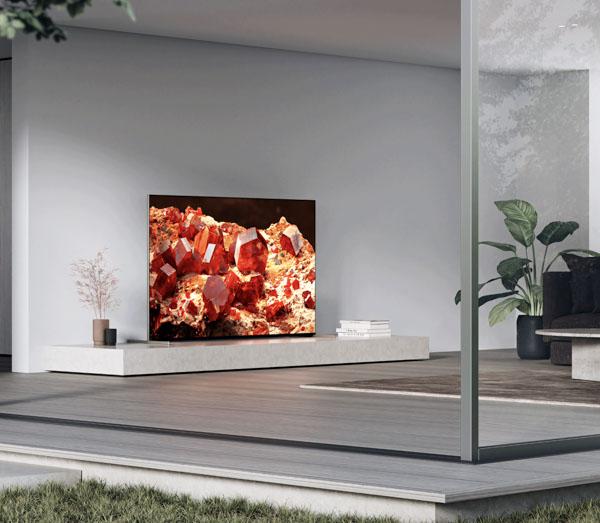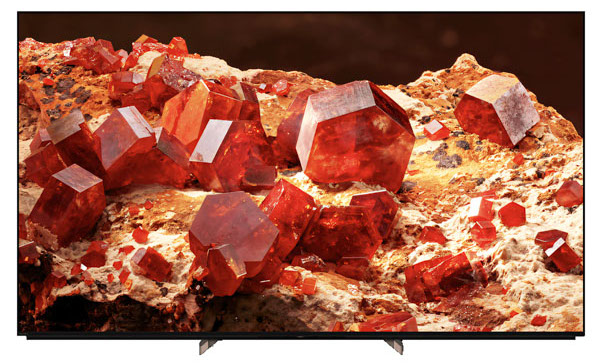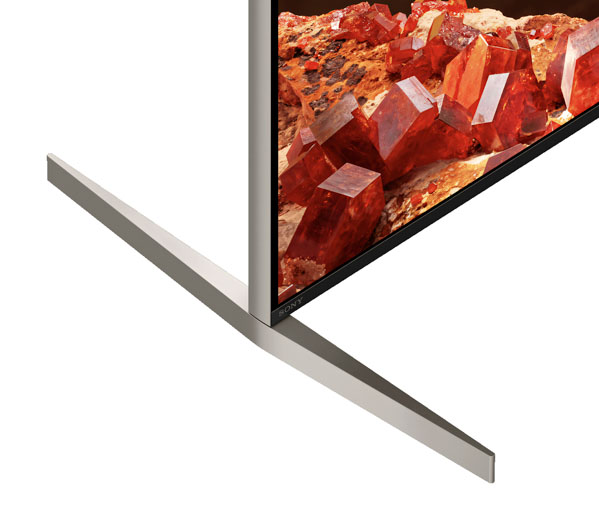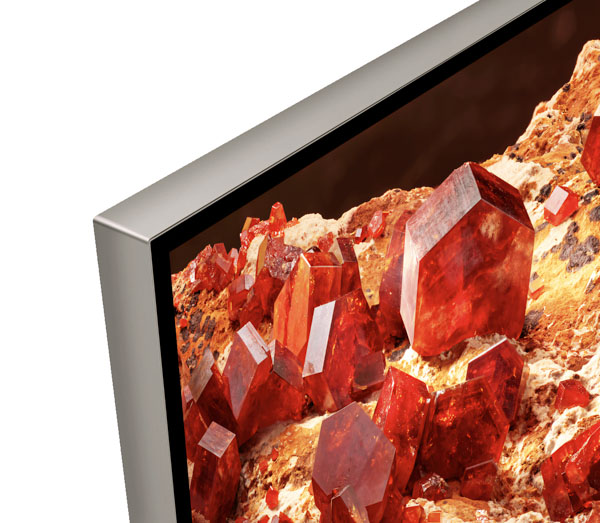Sony Bravia X93L Mini-LED 4K Google TV Review

AT A GLANCE
Plus
Black levels
Superb color
Affordability
Minus
Menu ergonomics
Remote control
THE VERDICT
Even before calibration, this Sony produced superb images. But calibration truly brought out the best from it in both HDR to SDR. Our samples offered slightly less luminance in HDR than expected, but that was quickly forgotten once the lights dimmed and the viewing began.
For several years now OLED has been king of the HDTV hill, offering the best available HDTV performance. This isn't to say that it has been free of issues; no technology is perfect. Early on, OLEDs had a reputation for being subject to burn-in. While that was overstated, it was still a concern that careful owners worked to avoid. Owners were advised not to leave still images, particularly bright ones, on the screen for extended periods—watch out for those bright scoreboards in otherwise active scenes. But I've lived with OLEDs for years now, often with largely stationary scoreboards at the bottom of the screen, and never had a trace of permanent burn-in. To be fair, however, I don't drive my TVs particularly hard.

One OLED limitation that has always been an issue, however, is lower available brightness compared to the better LCD televisions. However, LCDs have traditionally lacked the deep, inky blacks exhibited by a good OLED. The difference becomes glaringly evident when viewing a starfield against the blackness of outer space on an OLED compared to an LCD.
But the advent of LCD local dimming allows the backlighting needed by an LCD television to be dimmed (or turned off) in areas of the screen that should be dark or black as required by the source content, without affecting brighter areas of the image. More recently, this technology has been significantly improved by the advent of mini LEDs. Much smaller than conventional LEDs, a large number of mini LEDs, controlled by sophisticated microprocessing, can challenge OLED technology in the ability to produce pristine blacks.
OLEDs are still the champs for many TV consumers, and with good reasons. But mini LED designs have impressed me recently and Sony's X93L, our subject here, is a potent example.
A widespread meme in current HDTV circles argues that this year's X93L is simply a rebadging of Sony's X93K from 2022. That's only partially true. Externally, the two designs do appear identical. But there have been added tweaks to the 2023's micro processing, and the Bravia X93L is also significantly less expensive than the X93K.
Beyond the 65-inch model reviewed here, the Japanese-designed and Mexico-built X93L is also available in 75-inch and 85-inch versions. A more upscale X95L is also available but only in an 85" model.
Setup and Features
The X93L's dual-legged stand can be positioned in one of two ways: the two legs can be positioned near enough to the center to accommodate a narrow table, or near the set's outer edges. In the latter position the legs can also be extended slightly to raise the set enough to allow sufficient space for a soundbar. Wall mounting is of course another option, though a suitable wall bracket must be purchased separately. The Sony is a bit thicker and heavier than a similarly sized OLED, but it's not difficult for two people to unpack and set up with a table mount.
The connections on the back include four HDMI inputs. Two of them are HDMI 2.1, the other two are HDMI 2.0. Sony has long-delayed making all of their HDMI connections 2.1, but I suspect that two 2.1 inputs should be all that most users will need for now and into the foreseeable future. One of the HDMI 2.1 inputs would be sufficient for 120Hz games on a gaming console, and the other HDMI 2.1 input can service another console for the heavy gamer. One of the HDMI 2.1 inputs also serves as this Sony’s eARC port.

The X93L offers a range of desirable gaming features. These include 120Hz at 4K (from the HDMI 2.1 inputs), VRR, ALLM, and a game-specific menu. Sony's XR Cognitive processor supports these, along with performing the processing for a long list of additional features. I turned off many of these options in my critical viewing, but I did find that the Auto setting of Sony's ubiquitous Reality Creation feature produced a very subtle increase in detail without ever being obtrusive. But I typically ignore features related to noise reduction, various enhancements, and anything related to motion smoothing in all but the most egregious situations.
External programming can be accessed for display on the Sony via the usual routes (cable, disc players, streaming, and even Bluetooth). You can also share content on the X93L from an iPhone, iPad, or Mac via Sony's AirPlay feature.
Sony now uses Google TV as its Smart TV platform. It's no surprise that the full Google treatment links to a wide range of movies, shows, and other features. That's the nature of all Smart TV platforms. I didn't sign up for a Google account for this review. This offers even more added content I didn't want or need beyond what was already available to me, plus giving Google a dossier of my viewing habits to share with advertisers.

The Sony is compatible with all the most widely used HDR sources, including Dolby Vision, HDR10, HLG, Netflix Calibrated Mode, IMAX Enhanced, and BRAVIA Core Calibrated Mode (the latter unfamiliar to me!). It also works with Alexa, Apple Airplay, and Apple HomeKit vocal assistants, plus voice control via the remote. Sony’s remote control wasn't one of my favorites. It's small, all black with small buttons, and isn't backlit. I do a lot of serious viewing (and calibrating) in the dark or near dark, and the lack of backlighting is a significant issue, especially given my aversion to using voice assistants.
Sony's X-Anti Reflection feature is designed to do what the name suggests. It works reasonably well if there are bright, busy images on the screen to help hide reflections. But with darker screen content, or with the set turned off and light from a lamp or a window near or behind the viewer, reflections were visible. That's hardly a deal killer; any TV should be positioned as well as possible to minimize reflections from lights in the room falling onto the screen.
Another feature, Sony's X-Wide Angle, is designed to offer consistent viewing from off-center seats. This is traditionally an issue with many LCD-based televisions (to repeat an important point here for newbies, any mini-LED television is simply a sophisticated variation of LCD technology, despite the name). X-Wide Angle isn't perfect, and not as effective off center as are OLEDs which always offer superb viewing from any angle. But the degradation of the Sony's image as viewed from any reasonable off-center seat is unlikely to bother most viewers seated less than 45-degrees from the center. The guests for your upcoming Super Bowl party won't need to huddle cheek to cheek.
Since my last Sony review the menu layout has changed. I can't say I'm thrilled by the new layout, but over time I became accustomed to it. The options appear on the right side of the screen, and when the desired selection is reduced to the lower right-hand corner (by hitting "Enter"), its presence on the screen doesn't skew the calibration results--an issue with the menus on some TVs. One welcome change is that once you're in the menu you can hold the down button on the remote and the selection will quickly scroll down to the color adjustment part of the menu (2-point high and low color, 10-point color, and a Color Management system) and stop there. Those are the controls a calibrator will likely spend the most time with.
The X93L uniformity on full-screen white windows was excellent, with no visible blotches or DSE (dirty screen effect). Sony's motion handling was excellent, though I never felt the need to engage Sony's Motionflow feature. In the latter's Clearness setting, adjustable dark frame insertion may also be engaged. The number of local dimming zones wasn't possible to determine given the tests available to me, but it's clearly very high (Sony doesn't specify the number of zones).
The Sony wouldn't cleanly upscale 2:2 and 3:2 sources from an early Spears & Munsil test disc, an issue that was handled correctly when an Oppo Blu-Ray player did the upconversion. But I saw no similar artifacts on any other program material I viewed, either in SDR and HDR.
I used Custom Picture Mode throughout this review for both SDR and HDR. Out of the box, the SDR settings for the Brightness and Contrast controls were at 35 and 90 respectively. But in those settings, I found the Sony's SDR performance far too bright for comfort in my situation. I left Brightness at 35 but dropped the Contrast down to around 70. The optimum SDR settings for you may well differ based on your preferences and the light level in your room. While I calibrated SDR at the out of the box 35 and 90 respectively, reducing these settings had no significant effect on the quality of the post-calibration results.
For optimum HDR performance, however, the Brightness and Contrast settings must be set to at least Max and 90 respectively. If you use any settings other than 35 and 90 for SDR you'll need to manually reset those controls to Max (Brightness) and 90 (Contrast) for HDR. In fact, in my testing I found that the best measured HDR results, by a small degree, were achieved with both Brightness and Contrast set to Max.
The Sony's audio is also impressive. The two channels (left and right) each has its own woofer and tweeter. During the testing I never felt an irresistible urge to fire up my main audio system. Of course, the main reason for that was I didn't want to be distracted by the latter's bigger, more enveloping sound when the Sony's visuals were front and center here. But the Sony even on its own offered clean dialogue, a subtle taste of envelopment on some sources, and no audio quirks that took me out of the experience. But it's important to point out that the position of any TV will drastically affect its sound. As used here, the Sony was on a tabletop and well clear of adjoining walls because this offered the most convenient access to both the front and the back of the set.
Viewing
Even out of the box and before any calibration the Sony X93L offered a level of performance that will likely delight most viewers. But its peak HDR luminance, while good, was a few notches lower than anticipated. This prompted the delivery of a second sample. The peak output of sample 2 wasn't all that different and is the one calibrated, viewed, and reported on here. We've tested HDTVs with higher peak HDR brightness levels, but for reasons addressed in the Test Bench, no buyer is likely to be anything but delighted by both the HDR and SDR performance of the Sony X93L.
Beginning with HDR, the demonstration material on the latest Spears & Munsil Ultra HD Benchmark test discs looked nothing short of exceptional on the Sony. With the source material set to 10,000 nits I was blown away by the results with only one exception: the multi-level white details on a shot of horses in the snow (well known to calibrators and dedicated video enthusiasts as a killer test) exhibited serious white clipping. But at lower selected peak white levels (the demo can be viewed at a range of peak levels), visible clipping was insignificant. While there are commercial movie discs mastered at a peak level of 10,000 nits, lower peak levels, including 1000 nits, are more common.
Prometheus was the least effective of the HDR discs I sampled. But while it's very dark throughout most of its length, as was intended by the director and appropriate for the film's story, it's a shade darker than I recall from earlier viewings on other displays. The scene of the android David, as he discovers a holographic, starscape "map" to earth in the buried alien ship, was a little less gripping than I recall from previous encounters on other sets. Nor can the Sony, like all LCD/LED sets, produce starfields as brilliantly as an OLED can. Nevertheless, an early shot of the ship Prometheus, trudging through space with stars behind it and the ship's fiercely bright engines firing away was more than impressive.
Guardians of the Galaxy Vol.2 starts off well but grows progressively more potent. Once we get to the battle scenes my only response was W0W! With all the fires churning (and I do mean fires; the bright fires and explosions here jump out and grab you), not to mention the vividly bright ships of the Sovereigns as both they and Peter Quille's father come after the Guardians from all directions for different reasons. It's a light show of epic proportions and the Sony ate it all up.

But when it comes to the brilliant colors HDR can produce, nothing can beat a vivid helping of animation. Trolls World Tour may not be in the first tier of animation as a story, and is more than a little weird, but the color and detail it offered on the Sony never let up as Poppy and company travel to find the Hard Rock Queen, and save the music individuality of the many realms of Troll-dom. The least vivid realm, but the most fun, was Country, (it gets the best musical number!). If there's a more colorful 4K UHD Blu-ray around I've yet to see it. It was a treat from beginning to end on the Sony.
You might think that viewing vanilla SDR would be anticlimactic after all that, but you'd be wrong. I began by watching a 20-year-old Pioneer demo Blu-ray, mastered with a wide and strikingly vivid assortment of demo material. Even its audio as heard on the Sony was impressive (Pioneer knew what they were doing way back then!). I'll just say here that the 2K video on this disc would challenge almost any SDR video you'll find today. On the Sony it was a standout.
Set in the pre and early Victorian years, I chose The Young Victoria for its colorful production design. The Sony didn’t disappoint. While the production lacks the crisp resolution of Victoria and Abdul (a similar story but set decades later, its production details were a treat on the Sony (as was Emily Blunt in the title role!).
Staying the Victorian era, but in a very different film, we have 1964's Zulu. It's a superb production that would never be made today with changed attitudes toward empires. But that takes nothing away from either the story or the outstanding Blu-ray as viewed on the Sony X93L.The film was originally shot in Super Technorama 70. How much of that process’s low-grain, high resolution quality made it through to the Blu-ray I can't say. But the Sony looked magnificent on this film, from the bright red British Army uniforms to the dusty, near arid environments of southwest Africa. The X93L also revealed details you probably weren't intended to notice. There are many scenes here that appear to have used well-produced mattes during production, with foreground characters and elements (possibly shot in a studio) layered atop background environments. This process couldn't hide from the crystal-clear Sony.
A few further words are appropriate here about the X93Ls black level performance. It was easily comparable to what I've seen from OLEDs. When the source calls for total blacks, that's what you get. If those blacks are hard up against the edge of the screen in a fully darkened room, you can't differentiate between the blacks on the screen and the area beyond the screen's borders. Shadow detail was also impressive. This mini-LED might not be an OLED killer, but it's certainly a challenger.
Test Bench
All the measured results here were taken using Calman measurement software from Portrait Displays, together with X-Rite i1Pro3 Plus and Klein's K-10A color meters, and a Fresco 6G pattern generator from Murideo.
Some of today's HDR-capable TVs, such as this Sony, are designed so that after you calibrate for SDR the set itself automatically tweaks the settings to optimize the results for HDR when you switch to an HDR source. The visible SDR settings in the menus remain unchanged in this situation; the electronic tweaks needed by the HDR material are performed inside the set and invisible to the user. But I had some trouble with this, likely due to my own fumble-itis when it comes to computers. So I did it in reverse, first doing a full calibration in HDR and then checking SDR to see if this process works in reverse. At least on the Sony, it did.
HDR10
Full-on, Full-off Contrast Ratio: 448,455:1
The maximum HDR output I measured from the X93L was 986.6 nits (this was the second X93L sample we checked and the first was only a little different). The set’s ECO mode was turned Off on both samples. I also confirmed this by disconnecting most of the test setup and used just the Murideo test pattern generator connected directly to a Minola LS-100 luminance meter, which measured 1084 nits in HDR--only marginally different from the full test setup (Murideo pattern generator, computer running Calman 2023 for Business, and a Klein colorimeter profiled against an X-Rite i1Pro3 Plus for color accuracy. Overall these results are about 30% lower than has been reported elsewhere. The only plausible explanation for this discrepancy would be batch-to-batch variations, though this is unlikely.
On the upside here, keep in mind that human vision isn't linear; perceptually, a luminance increase of 25% is relatively small. If this were not the case, we'd all go blind in the transition from dawn to noon. In addition, many (but not all!) HDR sources are limited to 1000 nits. I also ran an HDR test showing the peak light output vs window size, and the X93L peaked at just over 1000 nits on a 15% window, smoothly tapering down to just over 500 nits at the lowest (small window) and highest (full screen) extremes. Most HDR HDTVs we've tested are less uniform than this in their brightness vs window size results.
Delta E is a figure of merit that indicates how closely a display adheres to the color standard. Experts generally agree that at Delta E levels below 3.0-4.0 (most argue for 3.0) the result is visibly indistinguishable from perfect tracking. Delta E values are also typically used to characterize the accuracy of either white balance (grayscale), or individual primary and secondary colors.
Post HDR calibration, all of the color Delta Es were below 3.2 (cyan) with none of the others over 2.8. The luminance Delta Es (from 10% to 100%) averaged 1.3 with a maximum of 2.4.
On a color-match color checker test, measuring the Delta Es on a wide range of colors, the average without luminance was 0.79 and the peak 2.49. With luminance errors, the average was 2.06 and the maximum 6.2.
BT.2020 saturation sweeps produced a respectable result apart from green and cyan, which were poor as they are on most consumer displays. But no present or anticipated consumer sources can achieve BT.2020). The results were far better on P3 color inside BT.2020 with Delta Es averaging 2.4 with peaks at 4.4--the latter only at the 100% level (they never exceeded 3.4 at 80% and below).
Using the 1976 standard, the Sony X93L covered 72.3 of BT.2020 color and 94.4% of P3 color.
SDR
Full-on, Full-off Contrast Ratio: Unmeasurable
The SDR results were produced with the Brightness set to 35 and the Contrast to 90, as they arrive out of the box. This produced an output level of 414 nits, or 121 foot-lamberts. The brightness was 0.000 nits, resulting from the unmeasurable result shown above. As discussed in the review, you can turn these two controls down if that result is too bright for you (as it was for me). Lowering either or both of these control for SDR didn’t materially alter the calibrated results.
After calibration, the SDR luminance Delta E values of the X93L never exceeded 2.9 (at 20%; with a low of 0.6 at 100%). The color Delta Es remained at or below 1.8 except for Blue at 4.0. A color checker produced an average Delta E of 1.4 and a peak of 4.8 (the latter for 100% blue).

Specs
Dimensions (W x H x D, inches): 56.875 x 32.875 x 2.5 (without stand); 56.875 x 35.75 x 13.6255 (with stand)
Weight (pounds): 70.8 (without stand); 72.7 (with stand)
Video Inputs: HDMI 4 (2 x HDMI 2.0, 2 x HDMI 2.1), eARC on HDMI 3, AV (L/R audio/composite video) with adapter, Cable/Antenna
Audio Outputs: Optical digital (TosLink)
Other: Ethernet, 2 x USB
